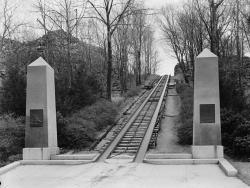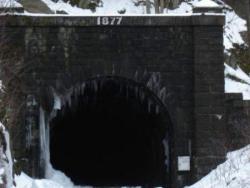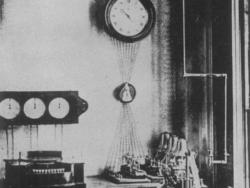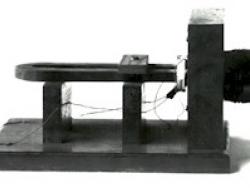MA


George Washington's concern over standardization of rifles for the Continental Army led to the formation of national armory and to his selection of Springfield as its site. Completed in 1794, it was the first national armory in the United States. Like the Robbins and Lawrence Armory, the Springfield Armory was an outstanding machining center for the design and mass production, employing notable engineers such as Thomas Blanchard (1788-1864), Thomas Warner, and Cyrus Buckland.

Designed, patented, and built by Thomas W.H. Moseley, this arched 96-foot span bridge preceded by years the standard use of wrought iron for bridges. For the first time in the United States, Moseley incorporated the use of riveted wrought-iron plates for the triangular-shaped top chord.

Minot's Ledge is a wave-swept rock formation in a rocky area of ocean about a mile off the Cohasset shore near Boston. Numerous serious shipwrecks prompted the government to erect a beacon there, and construction began in the summer of 1847.
The light, constructed on tall iron legs, was put into operation on January 1, 1850. Designers believed that the water would flow freely through the legs, leaving the lighthouse intact. But a terrible winter storm toppled it in 1851, killing the two assistant keepers.

The Old Mill, a smock type of windmill, believed to be the oldest operating windmill in the United States. Most of its parts are original. This mill is the sole survivor of four that once stood along the range of hills west of the town of Nantucket. The long spar and wheel rotate the top of the mill and turn the sails into the wind. Inside, visitors can watch the gears as corn is ground into meal, producing about 5 bushels an hour. Documentation of the restoration of the windmill is located at the Nantucket Historical Association's Research Center.
While the Erie Canal has become well-known in the annals of American history, the Middlesex Canal, built two decades earlier and a model for canal engineers throughout young America, has only recently become recognized for its important achievements. Extending 27 miles northeast from Boston harbor to the Merrimack River near present-day Lowell, Masachusetts, the Middlesex Canal provided low-cost and efficient freight transport for almost five decades, helping to establish the canal in the U.S. as a viable means of economic development.

This machine is an unusual triple-expansion, three-crank rocker engine, which in its day was a high-capacity unit providing outstanding performance for the Boston Water Works Corporation. Designed by Erasmus Darwin Leavitt, Jr. (1836-1916), Engine No. 3 was installed in 1894 to a high-service pumping facility on the south side of the Chestnut Hill Reservoir in Brighton.

Some of the station's notable achievements:
The first method for detecting radioactive particles in water supplies
A successful system of slow-sand filter beds for drinking water
The landmark demonstration that microorganisms carried within filter media could degrade sewage

The Charles River Basin was one of the pioneering environmental engineering projects in America. The project transformed 675 acres of unhealthy and unsightly salt marshes and tidal flats were into an environmental centerpiece for the Boston area by 1910. This was one of the first public projects to radically improve the environment and has served as a model for similar projects around the nation.


The Granite Railway Company of Quincy was the first commercial railway in the United States. Incorporated in 1826 and designed by Gridley Bryant, the railway relied on horses, rather than steam locomotives, to draw the cars along the tracks. Its primary purpose was to transport granite from…
Read More
When first proposed in 1819, the Hoosac Tunnel seemed so logical. It would provide an efficient and direct route for the Boston and Albany Railroad, whose pathway meandered 20 miles along precipitous grades. Early proponents, however, could not have imagined that blasting a 4.75 mile tunnel…
Read More
On 28 April 1852 the first municipal electric fire alarm system using call boxes with automatic signaling to indicate the location of a fire was placed into operation in Boston. Invented by William Channing and Moses Farmer, this system was highly successful in reducing property loss and deaths…
Read More
The first transmission of intelligible speech over electrical wires took place on 10 March 1876. Inventor Alexander Graham Bell called out to his assistant Thomas Watson, “Mr. Watson, come here! I want to see you.” This transmission took place in their attic laboratory located in a near here at…
Read More
On 24 December 1906, the first radio broadcast for entertainment and music was transmitted from Brant Rock, Massachusetts to the general public. This pioneering broadcast was achieved after years of development work by Reginald Aubrey Fessenden (1866-1932) who built a complete system of wireless…
Read MoreReferred to as the "catalyst of the Industrial Revolution," textile manufacturing helped to transform the American economy from an agricultural to a manufacturing economy. It led to transitions from human to mechanical power and from wood to metal construction. Population shifts resulted from…
Read More
On March 16, 1926 Dr. Robert H. Goddard, also known as "the father of modern rocketry," launched the world’s first liquid propellant rocket from a point 1000 feet S.S.E. of the plaque on the property of the Asa M. Ward Family. Erected by the American Rocket…
Read More

